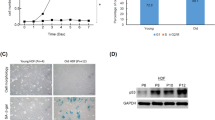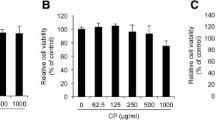Abstract
Ophiopogonis Radix (Ophiopogon root), which nourishes the yin, has been used in clinical practice to promote fluid secretion and to moisturize the lungs and skin in traditional Chinese and Japanese (Kampo) medicine. To evaluate this traditional medicinal effect, we investigated the anti-chronic inflammatory effect of Radix Ophiopogonis on senescent cells. Conversely, although several phenotypes of Ophiopogon japonicus Ker-Gawler (Liliaceae) are prevalent in Japan and China, we used these Ophiopogon roots by considering them as one crude drug, Ophiopogonis Radix. In this study, it was revealed that there are two chemotypes (Types A and B) in the root of the original plant, O. japonicus. Methylophiopogonanone A (compound 1) and methylophiopogonanone B (compound 2) were isolated as index compounds from Type A and compound 1 and ophiopogonanone A (compound 3) from Type B. In addition, ophiopogonin B (compound 4) was isolated as the main steroidal saponin from both Type A and B. The results indicated that two different methanol extracts (from Types A and B) and the main constituents of O. japonicus (compound 1–4), significantly downregulated the expression of interleukin (IL)-6 and IL-8, which were enhanced by senescent normal human dermal fibroblasts. Moreover, the two different methanol extracts and compounds 1–4 decreased IL-6 production in a strong and concentration-dependent manner by the ELISA method.







Similar content being viewed by others
References
Chen MH, Chen XJ, Wang M, Lin LG, Wang YT (2016) Ophiopogon japonicus—a phytochemical, ethnomedicinal and pharmacological review. J Ethnopharmacol 181:193–213
Fang J, Wang X, Lu M, He X, Yang X (2018) Recent advances in polysaccharides from Ophiopogon japonicus and Liriope spicata var. prolifera. Int J Biol Macromol 114:1257–1266
Zhao JW, Chen DS, Deng CS, Wang Q, Zhu W, Lin L (2017) Evaluation of anti-inflammatory activity of compounds isolated from the rhizome of Ophiopogon japonicus. BMC Complement Altern Med 17:7
Watanabe S, Kawamoto S, Ohtani N, Hara E (2017) Impact of senescence-associated secretory phenotype and its potential as a therapeutic target for senescence-associated diseases. Cancer Sci 108:563–569
Rea IM, Gibson DS, McGilligan V, McNerlan SE, Alexander HD, Ross OA (2018) Age and age-related diseases: role of inflammation triggers and cytokines. Front Immunol 9:586
Campisi J (2013) Aging, cellular senescence, and cancer. Annu Rev Physiol 75:685–705
Takata T, Motoo Y, Tomosugi N (2014) Effect of Saikokeishito, a Kampo medicine, on hydrogen peroxide-induced premature senescence of normal human dermal fibroblasts. J Integr Med 12(6):495–503
Xie L, Tsaprailis G, Chen QM (2005) Proteomic identification of insulin-like growth factor-binding protein-6 induced by sublethal H2O2 stress from human diploid fibroblasts. Mol Cell Proteomics 4(9):1273–1283
Chen JH, Stoeber K, Kingsbury S, Ozanne SE, Williams GH, Hales CN (2004) Loss of proliferative capacity and induction of senescence in oxidatively stressed human fibroblasts. J Biol Chem 279(47):49439–49446
Tada A, Kasai R, Saitoh Y, Shoji J (1980) Studies on the constituents of ophiopogonis tuber. VI. Structures of homoisoflavonoids. (2). Chem Pharm Bull 28(7):2039–2044
Tada A, Kasai R, Saitoh Y, Shoji J (1980) Studies on the constituents of ophiopogonis tuber. V. Isolation of a novel class of homoisoflavonoids and determination of their structures (1). Chem Pharm Bull 28(5):1477–1484
Asano T, Murayama T, Hirai Y, Shoji J (1993) Comparative studies on the constituents of ophiopogonis tuber and its congeners. VIII. studies on the glycosides of the subterranean part of Ophiopogon japonicus KER-GAWLER cv. Nanus. (2). Chem Pharm Bull 41(3):566–570
Lim H, Park H, Kim HP (2015) Effects of flavonoids on senescence-associated secretory phenotype formation from bleomycin-induced senescence in BJ fibroblasts. Biochem Pharmacol 96(4):337–348
Kevin M, Perrott CD, Wiley J (2017) Apigenin suppresses the senescence-associated secretory phenotype and paracrine effects on breast cancer cells. GeroScience 39:161–173
Acknowledgements
The authors are grateful to Dr. K. Minoura for NMR spectra recordings and Dr. M. Fujitake for mass spectra recordings at the Osaka University of Pharmaceutical Sciences.
Author information
Authors and Affiliations
Corresponding author
Rights and permissions
About this article
Cite this article
Kitahiro, Y., Koike, A., Sonoki, A. et al. Anti-inflammatory activities of Ophiopogonis Radix on hydrogen peroxide-induced cellular senescence of normal human dermal fibroblasts. J Nat Med 72, 905–914 (2018). https://doi.org/10.1007/s11418-018-1223-9
Received:
Accepted:
Published:
Issue Date:
DOI: https://doi.org/10.1007/s11418-018-1223-9




